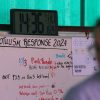The southwestern United States is experiencing a record-breaking heatwave, with San Francisco recording its hottest day of the year and Phoenix setting a new record for the hottest 1 October. Temperatures soared to 100°F (38°C) or higher across many areas, prompting the National Weather Service to issue warnings of excessive heat, heightened wildfire risks, and the potential for power outages.
The heat is also exacerbating health risks, particularly for vulnerable populations such as the unhoused and elderly, with concerns about a rising death toll from heat-related illnesses.
In San Francisco, temperatures reached 93°F, with other parts of the Bay Area experiencing temperatures up to 25°F above normal for October. This extreme heat led to cancellations of outdoor activities, including school sports, as the region sweltered under the unseasonable temperatures.
The National Weather Service extended excessive heat warnings to San Francisco and surrounding areas, advising caution and preparing for potential disruptions from the extreme weather.

Phoenix, meanwhile, continued to break heat records, with the city reaching 113°F (45°C) on Tuesday, marking another milestone in an already scorching year. Phoenix has experienced 67 days above 110°F in 2024, a stark contrast to the average of around 21 such days in previous decades.
This relentless heat has contributed to a troubling spike in heat-related fatalities, with more than 666 deaths recorded so far this year, including both outdoor and indoor deaths. Unhoused individuals are particularly at risk, as the extreme temperatures can cause burns from hot surfaces like sidewalks and asphalt.
The heatwave’s toll on Phoenix’s population is evident, with nearly half of the heat-related deaths affecting unhoused people, who often lack access to cooling or shelter.
However, a significant number of heat fatalities have also occurred indoors, with some individuals dying in homes where air conditioners were either broken or turned off due to concerns over the high cost of electricity. Additionally, public health data reveals that around 40% of the victims in Phoenix were under the age of 50, underscoring the widespread dangers of the extreme temperatures.
Las Vegas and southern Nevada are also grappling with the heatwave’s deadly consequences. In 2024, the region has reported at least 342 heat-related deaths, the highest number ever recorded, according to the Las Vegas Review-Journal.
As temperatures remain dangerously high, the public health and safety risks continue to rise, with officials urging residents to stay hydrated, avoid outdoor activities during peak heat, and be mindful of the severe strain on power grids and cooling systems across the region.

